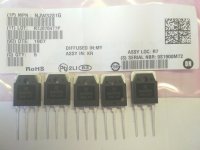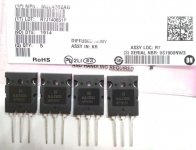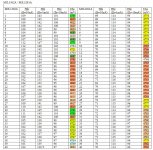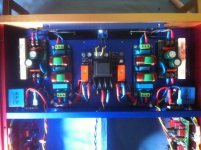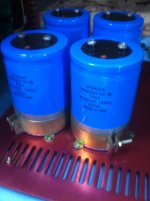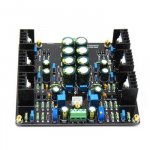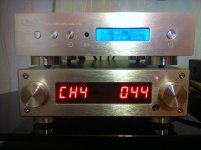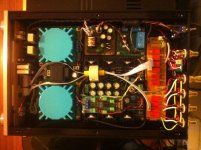In Russia, my trusted seller has 8 transistors for about $ 20 with delivery. It takes directly from the factory.
Attachments
I was laughing too.Not a word on how those were matched. The important thing is "not Made in CHINA cheap fakes". Utterly hilarious.

Erlend is a lucky guy who lives in a country where the word "integrity" has it's real meaning. He never had to put questions there, but on internet, on ebay, in a purchase from Chinese anonimous he is in a total Limbo. A chance to get original, new component there, equals to an absolute zero.
I am sory paroxod, but I'm still laughing.In Russia, my trusted seller has 8 transistors for about $ 20 with delivery. It takes directly from the factory.

Words "trust" and "friend" do not belong to busines relationships. Only good reputation matters. Trust me.
I think I know how they match them: they were found on the same junkyard.Not a word on how those were matched. ...

The conversation went on the transistors, the question is which is better to use MJL4281 / MJL4302, MJL3281 / MJL1302, NJW3281 / NJW1302, just do not send it to the datasheet, specifically in practice who used what or not. Which is better to use MJE15032 /33,MJE15034/35 ? At the moment I have a Chinese clone with MJL4281 / MJL4302 and MJE15034 / 35, a new one is being prepared for assembly, the choice continues.😉
Original electronic parts and ebay are mentioned together.... exciting
Displaying deviation of some parameters. It is a purchase from the Mouser, every piece is original naturally. This type is used in all of dartzeel amps, but it seems nobody want to build real dartzeel clone with dartzeel parts. I suppose the original dartzeel amplifiers are not too good...
Displaying deviation of some parameters. It is a purchase from the Mouser, every piece is original naturally. This type is used in all of dartzeel amps, but it seems nobody want to build real dartzeel clone with dartzeel parts. I suppose the original dartzeel amplifiers are not too good...
Attachments
Last edited:
But, of course we want clone with original parts. I wouldn't even think of having components retrieved from junkyard in my clone. Currently I'm buying from Farnell, originals I guess. And I'm using exactly parts you have just mentioned....nobody want to build real dartzeel clone with dartzeel parts. I suppose the original dartzeel amplifiers are not too good...
But, could you be more elaborate regarding these numbers? What impact they have on our decision making?
All parts in mine are original from trusted sellers. Ok amp but absolutely not my best. It's a grandmother amp nice sounding but zzzzz. Hope somebody will fix it with some feedback.😀😉
Indeed Erlend, good old times. 🙂>>Read this<< and I'm sure you're gonna like it...a grandmother amp nice sounding...
Dans JLH Class A Amplifier Site
We shall, but cryptic messages aren't helpful at all. Once upon a time I held lessons on chemistry (this is my real profession and I master it well) and people told me I was a good lecturer because I knew how to explain things in simple terms. Simplicity is reserved to those who understand. I hope somebody will once come here, ready to help, without cryptic talk.... Hope somebody will fix it with some feedback.😀😉
I'm optimistic. My clone sounds better with every next iteration. The most of my progres I may attribute to improvements in power supply and grounding.
Great work!
Powerful. 😎 I like that. Could you tell me which materials you use for the chasis?
PS: And right now I am starting a JLH project too, but 2003 version with regulated power supply.
Powerful. 😎 I like that. Could you tell me which materials you use for the chasis?
PS: And right now I am starting a JLH project too, but 2003 version with regulated power supply.
Last edited:
The Chinese volume control-switch of inputs in the case, built in the 1969 amplifier with a slight modification. Changed the power supply.

Attachments
Last edited:
We do not use fake parts, it is basic. "Dartzeel parts" do not mean only genuine electronic parts with the proper value.But, of course we want clone with original parts. I wouldn't even think of having components retrieved from junkyard in my clone. Currently I'm buying from Farnell, originals I guess. And I'm using exactly parts you have just mentioned.
But, could you be more elaborate regarding these numbers? What impact they have on our decision making?
Eg:
- R13, R14: 360Ohm resistor: You use Vishay RN55,Takman REY, Vishay Z-foil, etc
- C6,C7 3,3uF capacitor: You use Vishay MKP1841, Mundorf SGO, Nichicon Muse BP, etc
- C20-C32 capacitor: 22000uF-63V You use Yageo LH, Nichicon KG, Mundorf M-Lytic HC, etc
- high current wiring: some kind of wire
- etc
"dartzeel parts":
- R13, R14: 360Ohm resistor: Vishay Draloric SMA0207
- C6,C7 3,3uF capacitor: Wima MKS2C043301K00
- C20-C32 capacitor: 22000uF-63V Vishay BCcomponents MAL210118223E3
- high current wiring: Kimber Kable TCX
- etc
If you do not use "dartzeel parts" you will only build an amlifier which is built on the basis of dartzeel's schematic. It is not a real clone and its sound is not the real dartzeel sound which is provided by the manufactured dartzeel amps.
My transistor measurements can help to decide, how many pieces do you need to buy for pairs, quartet, octet, etc with a defined deviation of the parameters.
Last edited:
It is not a real clone and its sound is not the real dartzeel sound which is provided by the manufactured dartzeel amps.
Very true. Using appropriate parts you may end up with a better amp, or at least one more in line with your own taste 🙂
You are right and it is a nice thought. I think it can work concerning the most of amps but I think that as well the dartzeel is a special amp because of its high distortion.Very true. Using appropriate parts you may end up with a better amp, or at least one more in line with your own taste 🙂
Normally, to achieve the liked sound with unique electronic parts is an evolution. The first step is the knowing of the sound of manufactured amp. After that, you can start the swapping of part and you have chance to find combinations of parts which can provide a more preferable sound for you.
I do not see this process here, seemingly everyone knows the optimal parts on basis of some kind of theory. ( eg. the Mundorf silver gold oil cap will be better than Wima mks surely because it is written in a cap test or it is a high end part or it is work very well in an other circuit and I have excellent experimence with it, etc )
There is no real information concerning the difference between the manufactured and own amp. Rather, there is an own theory I built a better amp ( only for me ) than the extremely high-priced manufactured amp which is saleable on market and which has already proven in lot of high end systems and tests )
Thanks shany, I do appreciate your expertise. I will invest in these improvements....
If you do not use "dartzeel parts" you will only build an amlifier which is built on the basis of dartzeel's schematic. It is not a real clone and its sound is not the real dartzeel sound which is provided by the manufactured dartzeel amps.
...
However, there is something else I wanted to say.
A musician creates the sound, it is recorded and then mastered to represent an artistic work that goes to the audience in different forms available today. Between the artist and the audience there is equipment used to reproduce the work. The best is just air: an audience in front of the artists on the stage. That equipment is supposed to reproduce, not to compose.
Yesterday I have listened back-to-back to six different interpretations of Bach's Brandenburg concerto No. 5. There were many differences in tempo, in the selection of modern and antique instruments, some interpretations intended to give more modern tone some intended to reconstruct the sound of instruments from seventeenth century. Music is predominantly reproductive art and intervention of artist is the part of that reproductive process.
In the »audiophile« world logic however ceases to exist: it is indisputable that this amplifier has inherent distortion which can not be removed without a total redesign. But the tale is that »there is anyway 20 to 30% of harmonics in the sound of any instrument« and adding »just 1 %« doesn't make difference.
Wrong: the original sound consists of these 20-30% distortions, it is an integral part of the work itself, but adding extra distortion is unwanted intrusion. Just imagine someone telling you; the vine contains some sugar so we have added 10g per liter to make it taste more sweet.
This skewed logic is the foundation of esoteric, immeasurable quality of »Dartzeel« sound. It is the musician who decides to which extent to introduce distortions, not a machine, however it is prided in pay-for-play reviews. If that were true then any amplifier with 1% distortion is more than natural – it improves experience. But no, only Dartzeel does it in the right way.
As the matter of fact they couldn't get rid of distortion and they needed indeed a good excuse to declare the downside as the virtue worth substantial investment into a distorted amplifier. That is »unique« sound of the Dartzeel and it is a privilege to listen to it because it must be produced according to to the secret recipe with invisible ingredients known and visible just to those who swallowed the snake oil. Propaganda.
Right now I am playing with the idea of building JHL 10W Class A amplifier, the one with small amount of distortion, the one that doesn't compose. I am amazed to see such a variety of ideas and different sets of components over there in 10W Class A tread. It will be a great pleasure to experiment with that instead of seeking A Philosopher's Stone of Dartzeel Amplifier, The very Spirit of Music.
Last edited:
- Home
- Amplifiers
- Solid State
- Dartzeel amp schematic - build this?
